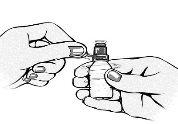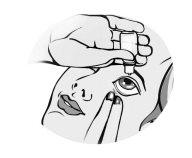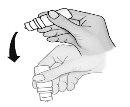

TAPTIQOM 15 micrograms/ml + 5 mg/ml eye drops solution

Ask a doctor about a prescription for TAPTIQOM 15 micrograms/ml + 5 mg/ml eye drops solution

How to use TAPTIQOM 15 micrograms/ml + 5 mg/ml eye drops solution
Introduction
Package Leaflet: Information for the Patient
Taptiqom 15 micrograms/ml + 5 mg/ml eye drops, solution
tafluprost/timolol
Read all of this leaflet carefully before you start using this medicine because it contains important information for you.
- Keep this leaflet, you may need to read it again.
- If you have any further questions, ask your doctor, pharmacist, or nurse.
- This medicine has been prescribed for you only. Do not pass it on to others. It may harm them, even if their signs of illness are the same as yours.
- If you get any side effects, talk to your doctor, pharmacist, or nurse. This includes any possible side effects not listed in this leaflet. See section 4.
Contents of the pack
- What is Taptiqom and what is it used for
- What you need to know before you use Taptiqom
- How to use Taptiqom
- Possible side effects
- Storing Taptiqom
- Contents of the pack and other information
1. What is Taptiqom and what is it used for
What kind of medicine is it and how does it work?
Taptiqom eye drops, solution, contain tafluprost and timolol. Tafluprost is a medicine from a group called prostaglandin analogues, and timolol belongs to a group of medicines called beta-blockers. Tafluprost and timolol work together to reduce eye pressure. Taptiqom is used when the eye pressure is too high.
What is your medicine used for?
Taptiqom is used to treat a type of glaucoma called open-angle glaucoma, a condition also known as ocular hypertension in adults. Both conditions are related to an increase in pressure in the eye and may occasionally affect your vision.
2. What you need to know before you use Taptiqom
Do not use Taptiqom:
- if you are allergic to tafluprost, timolol, beta-blockers, or any of the other ingredients of this medicine (listed in section 6).
- if you have or have had respiratory problems such as asthma, severe chronic obstructive pulmonary disease (severe lung disease that can cause wheezing, breathing difficulties, or prolonged coughing).
- if you have a slow heart rate, heart failure, or heart rhythm disorders (irregular heartbeat).
Warnings and precautions
Consult your doctor, pharmacist, or nurse before starting to use Taptiqom.
Before using this medicine, tell your doctor if you have or have had:
- heart disease (symptoms may include chest pain or tightness, shortness of breath, or difficulty breathing), heart failure, or low blood pressure
- heart rhythm disorders, such as slow heartbeat
- respiratory problems, asthma, or chronic obstructive pulmonary disease
- poor blood circulation (such as Raynaud's disease or Raynaud's syndrome)
- diabetes, as timolol may mask the signs and symptoms of hypoglycemia
- hyperthyroidism, as timolol may mask the signs and symptoms of thyroid disease
- any allergy or anaphylactic reaction
- severe myasthenia (a disease that causes muscle weakness)
- other eye diseases, such as corneal disease (the transparent tissue that covers the front of the eye) or a disease that requires eye surgery.
Tell your doctor if you have:
- kidney problems
- liver problems.
Be awarethat Taptiqom may have the following effects and some may be permanent:
Taptiqom may
- increase the length, thickness, color, or density of your eyelashes and cause unusual hair growth on your eyelids.
- cause darkening of the skin around the eyes. Wipe away any excess solution from the skin. This will reduce the risk of skin darkening.
- change the color of your iris (the colored part of your eye). If you use Taptiqom in one eye only, the color of the treated eye may become permanently different from the color of the other eye.
- cause hair growth in areas where the solution comes into repeated contact with the skin surface.
If you are going to have surgery, tell your doctor that you are using Taptiqom, as timolol may affect the effects of some medicines used during anesthesia.
Children and adolescents
Taptiqom is not recommended for children and adolescents under 18 years of age due to the lack of data on safety and efficacy in this age group.
Taking Taptiqom with other medicines
Tell your doctor or pharmacist if you are taking, have recently taken, or might take any other medicines.
Taptiqom may affect, or be affected by, other medicines you are taking.
In particular, tell your doctor if you use/take or plan to use/take:
- other eye drops for glaucoma treatment
- medicines to lower blood pressure
- heart medicines
- medicines for diabetes treatment
- quinidine (used to treat heart problems and some types of malaria)
- antidepressants known as fluoxetine or paroxetine.
If you use other medicines in the eye, wait at least 5 minutes between instilling Taptiqom and the other medicine.
Contact lenses
Remove your contact lenses before administering the drops and wait at least 15 minutes before putting them back in.
Pregnancy, breastfeeding, and fertility
If you are pregnant or breastfeeding, think you may be pregnant, or are planning to have a baby, ask your doctor for advice before taking this medicine. If you are a woman who can become pregnant, you must use an effective method of birth control during treatment with Taptiqom. Do not use Taptiqom if you are pregnant, unless your doctor has told you to. Do not use Taptiqom if you are breastfeeding. Ask your doctor.
Driving and using machines
Some side effects associated with Taptiqom, such as blurred vision, may affect your ability to drive or use machines. Do not drive or use machines until you feel well and your vision is clear.
Taptiqom contains phosphates
This medicine contains 1.3 mg of phosphates in each ml.
If you have severe corneal damage (the transparent layer on the front of the eye), treatment with phosphates, in very rare cases, may cause blurred vision due to calcium accumulation.
3. How to use Taptiqom
Follow exactly the instructions for administration of this medicine given by your doctor or pharmacist. If you are not sure, ask your doctor or pharmacist again.
The recommended dose is one drop of Taptiqom daily in the affected eye(s). Do not instill more drops or more often than indicated by your doctor. If you do, Taptiqom may lose its effectiveness. Use Taptiqom in both eyes only if your doctor has told you to.
For use only as eye drops. Do not swallow.
Do not let the multidose container touch the eye or the surrounding area. This could damage the eye. It could also become contaminated with bacteria that could cause eye infections leading to damage to the eye, including vision loss. To avoid possible contamination of the multidose container, avoid letting the tip of the container touch any surface.
Instructions for use:
When using it for the first time, before applying a drop to the eye, first practice using the bottle by slowly squeezing it to let a drop fall outside the eye.
When you are confident that you can apply a single drop each time, choose the most comfortable position for instilling the drops (you can sit, lie on your back, or stand in front of a mirror).
When starting a new bottle:
Do not use the bottle if the plastic ring around the neck of the bottle is missing or broken. Write the date you opened the bottle in the space provided for the date on the outer carton.
Each time you use Taptiqom:
|
|
|
|
Be particularly careful to avoid letting the tip of the dropper bottle touch your eye, the skin around your eye, or your fingers to prevent possible contamination of the solution.
Please note that there may be a small delay between squeezing the bottle and the drop falling. Do not squeeze too hard. |
|
|
|
|
|
A residual volume of approximately 1 ml will remain that cannot be administered. Do not attempt to empty the bottle.
If the drop falls outside the eye,try again.
If your doctor has told you to apply drops in both eyes, repeat steps 7 to 9 in the other eye.
If you use other medicines in the eye, wait at least 5 minutes between applying Taptiqom and the other medicine.
If you use more Taptiqom than you should, you may feel dizzy or have a headache, heart problems, or breathing difficulties. If necessary, consult a doctor.
If you swallow the medicine accidentally, consult a doctor or pharmacist or call the Toxicology Information Service, phone 91 562 04 20, stating the medicine and the amount taken.
If you forget to use Taptiqom, apply a single drop as soon as you remember and then return to your normal routine. However, if it is almost time for your next dose, skip the missed dose. Do not take a double dose to make up for forgotten doses.
Do not stop using Taptiqom without consulting your doctor. If you stop treatment with Taptiqom, the pressure in the eye will increase again. This could cause permanent damage to the eye.
If you have any further questions on the use of this product, ask your doctor, pharmacist, or nurse.
4. Possible side effects
Like all medicines, this medicine can cause side effects, although not everybody gets them. Most side effects are not serious.
Normally, you will be able to continue using the drops unless the effects are serious. If you are unsure, consult a doctor or pharmacist.
The known side effects of using Taptiqom are:
Common side effects(may affect up to 1 in 10 people):
Eyelid disorders
Itching of the eyes. Irritation of the eyes. Eye pain. Redness of the eyes. Changes in length, thickness, and density of the eyelashes. Sensation of a foreign body in the eye. Discoloration of the eyelashes. Sensitivity to light. Blurred vision.
Uncommon side effects(may affect up to 1 in 100 people):
Nervous system disorders
Headache.
Eyelid disorders
Dry eye. Redness of the eyelids. Small areas of inflammation on the surface of the eye. Watery eyes. Swelling of the eyelids. Tired eyes. Inflammation of the eyelids. Inflammation inside the eye. Eye discomfort. Eye allergy. Eye inflammation. Abnormal sensation in the eye.
The following additional side effects have been observed with the medicines that make up Taptiqom (tafluprost and timolol) and may therefore occur when using Taptiqom:
The following side effects have been observed with tafluprost:
Eyelid disorders
Reduced ability of the eye to see details. Change in iris color (may be permanent). Change in skin color around the eyes. Inflammation of the membranes on the surface of the eye. Eye discharge. Pigmentation of the membranes on the surface of the eye. Follicles on the membranes on the surface of the eye. Sunken eye. Iritis/uveitis (inflammation of the colored part of the eye). Macular edema/macular cystoid edema (inflammation of the retina inside the eye leading to vision impairment).
Skin disorders
Unusual hair growth on the eyelids.
Respiratory system disorders
Worsening of asthma, respiratory failure.
The following side effects have been observed with timolol:
Immune system disorders
Allergic reactions, including inflammation under the skin, hives, and eruptions. Sudden and potentially life-threatening allergic reaction. Itching.
Metabolism and nutrition disorders
Hypoglycemia.
Psychiatric disorders
Depression. Sleep disorders. Nightmares. Memory loss. Nervousness. Hallucinations.
Nervous system disorders
Dizziness. Weakness. Unusual sensations (such as tingling and pinching). Increased signs and symptoms of severe myasthenia (muscle disorder). Stroke. Reduced blood flow to the brain.
Eyelid disorders
Inflammation of the cornea. Reduced sensitivity of the cornea. Visual disturbances, including refractive changes (sometimes due to discontinuation of miotic therapy). Drooping of the upper eyelid. Double vision. Blurred vision and detachment of the layer under the retina, which contains blood vessels, after filtration surgery, which can cause vision disturbances. Corneal erosion.
Hearing disorders
Tinnitus (ringing in the ears).
Cardiac disorders
Slow heartbeat. Chest pain. Palpitations. Edema (fluid accumulation). Changes in heart rate or rhythm. Congestive heart failure (heart disease with difficulty breathing and swelling of feet and legs due to fluid accumulation). A type of heart rhythm disorder. Heart attack. Heart failure.
Vascular disorders
Low blood pressure. Claudication. Raynaud's phenomenon, cold hands and feet.
Respiratory disorders
Contraction of airways in the lungs (especially in patients with pre-existing disease). Breathing difficulties. Cough.
Gastrointestinal disorders
Nausea. Indigestion. Diarrhea. Dry mouth. Taste disturbances. Abdominal pain. Vomiting.
Skin disorders
Hair loss. Skin rash with a silvery-white appearance (rash like psoriasis) or worsening of psoriasis. Skin rash.
Musculoskeletal and connective tissue disorders
Muscle pain not caused by exercise. Joint pain.
Reproductive system and breast disorders
Peyronie's disease (which can cause curvature of the penis). Sexual dysfunction. Decreased libido.
General disorders
Muscle weakness/fatigue. Thirst.
Reporting of side effects
If you experience any side effects, talk to your doctor, pharmacist, or nurse. This includes any possible side effects not listed in this leaflet. You can also report side effects directly through the Spanish Pharmacovigilance System for Human Use Medicines: https;//www.notificaram.es. By reporting side effects, you can help provide more information on the safety of this medicine.
5. Storing Taptiqom
Keep this medicine out of the sight and reach of children.
Do not use this medicine after the expiry date which is stated on the label of the bottle and carton after "EXP". The expiry date is the last day of the month stated.
Store unopened bottles in a refrigerator (between 2 and 8 °C). Do not freeze.
Store the bottle in the original packaging to protect it from light.
After opening the bottle:
- Do not store above 25°C. Do not freeze.
- Store the bottle in the original carton to protect it from light.
- To avoid infections, the bottle must be discarded after 3 months of first opening. The 3 ml fill volume bottle is intended for 1 month of use, the 5 ml bottle for 2 months, and the 7 ml bottle for 3 months.
Medicines should not be disposed of via wastewater or household waste. Return the containers and any unused medicines to the pharmacy's SIGRE collection point. If you are unsure, ask your pharmacist how to dispose of the containers and any unused medicines. This will help protect the environment.
6. Package Contents and Additional Information
Taptiqom Composition
- The active ingredients are tafluprost and timolol. 1 ml of solution contains 15 micrograms of tafluprost and 5 mg of timolol (as maleate).
- The other components are glycerol, disodium phosphate dodecahydrate, disodium edetate, polysorbate 80, hydrochloric acid and/or sodium hydroxide, and water for injectable preparations.
Product Appearance and Package Contents
Taptiqom is a clear and colorless liquid (solution), practically free from visible particles. It is presented in a package containing 1 transparent plastic bottle containing 3 ml, 5 ml, or 7 ml, or 3 transparent plastic bottles with 3 ml of solution each. The plastic bottles are closed with stoppers.
Only some package sizes may be marketed.
Marketing Authorization Holder and Manufacturer
Marketing Authorization Holder
Santen Oy
Niittyhaankatu 20
33720 Tampere
Finland
Manufacturer
Santen Oy
Kelloportinkatu 1
33100 Tampere
Finland
Further information about this medicinal product can be obtained from the local representative of the marketing authorization holder:
Santen Pharmaceutical Spain S.L.
Acanto, 22, 7º
28045 – Madrid
Date of the last revision of this leaflet: November 2021
Detailed and updated information on this medicinal product is available on the website of the Spanish Agency for Medicines and Health Products (AEMPS) http://www.aemps.gob.es/
- Country of registration
- Active substance
- Prescription requiredYes
- Manufacturer
- This information is for reference only and does not constitute medical advice. Always consult a licensed doctor before taking any medication. Oladoctor is not responsible for medical decisions based on this content.
- Alternatives to TAPTIQOM 15 micrograms/ml + 5 mg/ml eye drops solutionDosage form: EYEDROP, 10 mg/ml + 5 mg/mlActive substance: timolol, combinationsManufacturer: Novartis Europharm LimitedPrescription requiredDosage form: EYEDROP, 0.3 mg/ml + 5 mg/mlActive substance: timolol, combinationsManufacturer: Brill Pharma S.L.Prescription requiredDosage form: EYE DROP, 0.3 mg/ml + 5 mg/mlActive substance: timolol, combinationsManufacturer: Laboratorio Stada S.L.Prescription required
Alternatives to TAPTIQOM 15 micrograms/ml + 5 mg/ml eye drops solution in other countries
The best alternatives with the same active ingredient and therapeutic effect.
Alternative to TAPTIQOM 15 micrograms/ml + 5 mg/ml eye drops solution in Poland
Alternative to TAPTIQOM 15 micrograms/ml + 5 mg/ml eye drops solution in Ukraine
Online doctors for TAPTIQOM 15 micrograms/ml + 5 mg/ml eye drops solution
Discuss dosage, side effects, interactions, contraindications, and prescription renewal for TAPTIQOM 15 micrograms/ml + 5 mg/ml eye drops solution – subject to medical assessment and local rules.



















